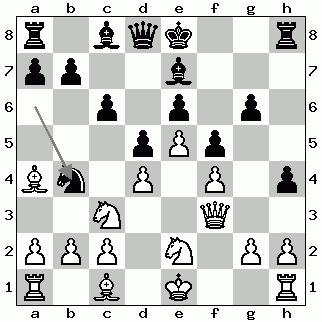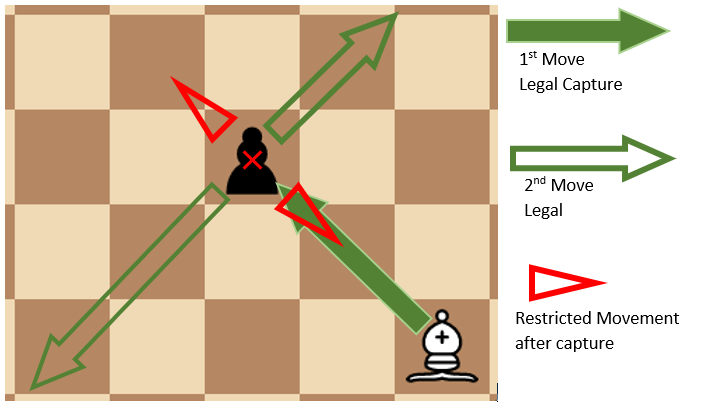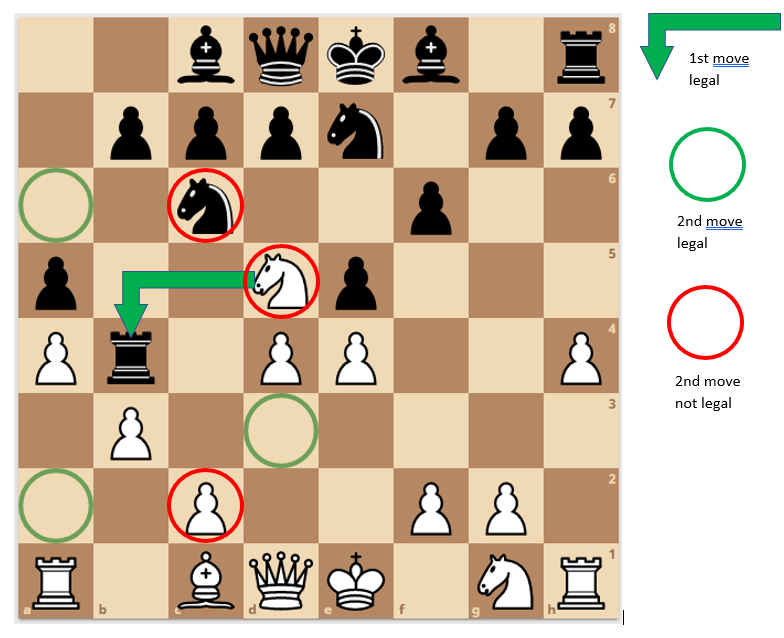Hit and Run Chess
Background – in the 80’s a good friend (Galth Ractus) and I decided to see if we could make Chess more challenging, yet still easy to remember. It is already a great game, but I really wanted to see if it could evolve to another level by taking more than one move a turn. So, after much playtesting we decided that upping the number of moves you can make each turn to two dramatically changed the game. (We did try 3 and 4 move variants, but they seemed fraught with issues and would require extensive changes to work.) After working out a few challenges to make sure the game was balanced and fair, we came up with what was dubbed Rune Chess, as I was running a BBS on my C64, dedicated to gaming, called Runestone BBS.
Over the years I have honed the rules and determined that playing Hit and Run Chess adds a whole new dimension to chess. I am not sure if it makes your chess game any better, but it sure makes you think at right angles.
If Chess represents a war, then Hit and Run Chess represents modern warfare. It moves quicker than standard chess while giving you the same challenging strategy and play, only at a new level.
Rules
Hit and Run Chess is played with a normal chess set with normal pieces, placement, and movement.
The big difference is the combination of pieces and moves you can make after the 1st turn.
- The 1st turn for each side is always played by standard chess rules; one move on each side.
- From there on both sides have the option of moving 1 piece twice or 2 pieces once.



The complete rules and stipulations follow:
- All turns after the first must consist of 2 moves on each side, in the following combinations.
- 2 pieces: Both move once.
- 1 piece: Moves twice.
- You cannot voluntarily move just once, but if you cannot legally take a second move with any piece (say the king would be put in check) your second move is forfeited.
- All captures, if they are made, must occur on any pieces first move.
- No single piece may ever capture on its second move.
- When moving 2 pieces, both may capture.
- If a piece makes a second move after it captures, it may not continue to move along the same path used to capture, nor is it allowed to return to it's original square (This mainly affects the Knight). (see below):
- Column ( i.e. castle, king, or queen )
- Row ( i.e. castle, king, or queen )
- or Diagonal ( i.e. bishop, king or queen )
- nor return to the same square from which the capturing piece started (i.e. a knight, but, as a rule, is not limited to just Knights. It is sort of a moot point for other pieces, though, as they would technically have to return along their original path to get to the starting square.).
- Pawns can only go forward after a capture, but they still have the ability to Double-Step on their very first move from their starting rank. So, potentially can get 3 steps forward rather than two, using both moves from their starting rank.
- Below we can see an Examination of the Queens Hit and Run Choices and an opinion of the best move. Whether a square is safe or not is fluid, depending on what was actually captured.







- If the king is in check, the first move must always resolve the threat. *
- Two pieces moving once is a legitimate first move defense against two seperate checks, however a third check, if not blocked by either of the moves would result in Checkmate.
- You cannot deliberatly put your King in check by moving a piece that blocks check, even if the next move would reinstate the block. Pieces are pinned in these circumstances, as in Standard Chess, and can only be moved when the pinning situation is resolved. Unless you are playing the Simultaneous Variant below. *
- Your turn does not end if Check takes place on the first move. You do not lose your second move, however, unless you wish to relinquish Check by moving the first piece again, your second move must be taken with another piece and the most you can do would be to reinforce the Check.(See Checkmate rules below.)
- All other basic chess rules apply.
- The 50 move rule is as much a thing in Hit and Run Chess as it is in standard Chess. (i.e. If a player is down to their king, they have 50 moves to survive or achieve Stalemate, while the attacker must achieve Checkmate before the moves run out.)
- Each move counts against the 50, so potentially 2 per turn, unless the second move is forfeit since a King cannot move into Check.
- If the defender can't make a legal 1st move it is always a Stalemate.
- Check Mate, Stale Mate, mutually agreed upon draw, are all only ever achieved through acceptance of fate on the defending Kings turn (Same as in Standard Chess).
- Check and Checkmate do not both occur in the same 2 move turn. Check takes place on the attackers 2 move turn. Checkmate occurs and is called on the defenders 2 move turn.
- The King always gets a chance to get out of Check. (Consider it an agreement among Kings, a professional courtesy extended to all Kings.)
- A stale mate is always in favor of the defender.
- Mutually agreed upon draw can happen at any time, as can concession.
- The revealed capture is a thing in this game, just not for Kings. All other pieces may be captured with a revealed move.
- Capturing en passant is allowed under standard and Double-Move conditions. (i.e. a pawn ends its turn adjacent to an enemy Pawn after taking a Double-Step, Double-Move, or both Double-Step/DoubleMove -Treble-Step?.)
- Having turns that consist of Double-Moves opens up the possibility for en passant captures to happen anywhere , rather than just from the Pawns starting point.
- Players may choose to limit Capturing En Passant to a standard Chess style, by making it only possible when the target pawn does a double-step or double-step/Double-Move from the starting Rank, as it is in Chess, and not wherever a faux "double-step" occurs (Pawn using a Double-Move to move forward 2 squares where the Double-Step is not available).
- If the moving Pawns second move puts it one step beyond adjacent with an enemy Kings Pawn, Capturing en passant is not possible. **
- It should be made clear, before play begins, or agreed upon before use, whether en passant is used, and what style is preferred, or not used at all.

It’s really simple, especially if you already know how to play chess.
Variations: (No matter the variation, no Kings may be captured without Check. If no Check was called, no King may be captured.)
- * Simultaneous Chess – Simply means that the results for both moves each player takes are considered simultaneously. Meaning you may move the king further to get out of check, even passing through a check situation to get out of check (the end justifies the means, so to speak), or another piece may make two moves to block.
- So long as both moves take place at the same time, the first move does not have to remove the check.
This usually results in much longer games requiring more pieces to pin the king. Although the King is the piece this variant most affects, it may have some situational benefits across the board.
- ** Enhanced en passant; – rather than simply allowing normal capturing en passant, it may be allowed even if the pawn takes a second move, putting it one step beyond adjacent, by utilizing a side-step which would result in an ending position similar to the normal capturing en passant end position.

Notes
Also Known as Pirate Chess Also Known as RuneChess This 'user submitted' page is a collaboration between the posting user and the Chess Variant Pages. Registered contributors to the Chess Variant Pages have the ability to post their own works, subject to review and editing by the Chess Variant Pages Editorial Staff.
This 'user submitted' page is a collaboration between the posting user and the Chess Variant Pages. Registered contributors to the Chess Variant Pages have the ability to post their own works, subject to review and editing by the Chess Variant Pages Editorial Staff.
By Stephen Howell.
Last revised by Stephen Howell.
Web page created: 2020-07-31. Web page last updated: 2020-07-31
